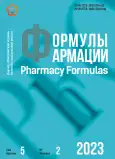Микрофлора инкубационных яиц и пути ее формирования
- Авторы: Горфункель Е.П.1, Ильина Л.А.1
-
Учреждения:
- Научно-производственная компания «БИОТРОФ»
- Выпуск: Том 5, № 2 (2023)
- Страницы: 65-69
- Раздел: Актуальные проблемы: дискуссионная трибуна
- URL: https://journals.rcsi.science/PharmForm/article/view/249543
- DOI: https://doi.org/10.17816/phf352544
- ID: 249543
Цитировать
Полный текст
Аннотация
В данном исследовании были получены результаты, отражающие содержание генетического материала бактерий в инкубационных яйцах. Учитывая широкое применение куриных эмбрионов в медицине, ветеринарии и фармакологии, выявление и идентификация микроорганизмов является важной задачей. В ходе исследования был проведен количественный и качественный анализ состава бактерий в различных тканях инкубационных яиц. Были отобраны три среднесмешанные пробы каждой типичной категории: хорион-аллантоисная оболочка (ХАО) на 8-й день инкубации, желточные мешки на 13-й, 18-й и 20-й дни инкубации. Исследование проводилось с использованием метода ПЦР в реальном времени (real-time PCR). Сбор проб и подготовка образцов осуществляли в соответствии с установленными стандартами, что позволило обеспечить надежность и точность полученных данных.
Ключевые слова
Полный текст
Открыть статью на сайте журналаОб авторах
Елена Павловна Горфункель
Научно-производственная компания «БИОТРОФ»
Автор, ответственный за переписку.
Email: elena@biotrof.ru
SPIN-код: 2958-6204
специалист по качеству
Россия, Санкт-Петербург, ПушкинЛариса Александровна Ильина
Научно-производственная компания «БИОТРОФ»
Email: biotrof@biotrof.ru
доктор биологических наук, начальник молекулярно-генетической лаборатории научно-производственной компании
Россия, Санкт-Петербург, Пушкин
Список литературы
- Шмаров М. М., Логунов Д. Ю., Черенова Л. В., Пикер Е. Г. Технология получения рекомбинантных аденовирусов CELO в куриных эмбрионах в препаративных количествах // Биомедицина. – 200 – № 1 – С. 112–113.
- Строганова И. Я. Куриные эмбрионы и их использование в вирусологии: метод. указания к лабораторным занятиям / И. Я. Строганова; Красноярcкий Государственный Аграрный Университет. – Красноярск, 2013. – 19 с.
- Монстакова Т. В., Азарнова Т. О., Кочиш И. И. Перспективы и преимущества использования эмбрионов кур как модельных систем для фармацевтических исследований на примере глициана кобальта // Ветеринарный фармакологический вестник – 2021 – № 2 – С .84–91.
- Нургазиев Р. З. Отработка оптимальных условий культивирования штамма вируса болезни Ньюкасла в развивающихся куриных эмбрионах / Р. З. Нургазиев, А. Р. Нургазиева, Е. Д. Крутская [и др.] // Вестник НГАУ (Новосибирский государственный аграрный университет). – 2019. – № 1(50). – С. 148–152. – doi: 10.31677/2072-6724-2019-50-1-148-152.
- Князева В. А. Исследование влияния магнитного поля и лазерного излучения на развитие опорно-двигательного аппарата куриного эмбриона / В. А. Князева, А. Г. Шутенков; науч. рук. Ф. И. Сулейманов // Молодежь – науке и практике АПК: материалы 102-й Международной научно-практической конференции студентов и аспирантов, Витебск, 29–30 мая 2017 г. / Витебская государственная академия ветеринарной медицины. – Витебск: ВГАВМ, 2017. – Ч. 1: Ветеринарная медицина и биологические науки. – С. 179.
- Пяткина А. А, Предельные дозы пенициллина, стрептомицина и амфотерицина-в для SPF-эмбрионов кур, рекомендуемые для вирусологических работ / А. А. Пяткина, Н. В. Мороз, Т. Н. Зыбина [и др.] // Ветеринарная патология. – 2020. – № 4(74). – С. 5–12. – doi: 10.25690/VETPAT.2020.51.32.005.
- Каде А. Х. Куриный эмбрион как объект эксперимента для изучения развития сердечно-сосудистой системы / А. Х. Каде, А. И. Трофименко, А. Ю. Туровая [и др.] // Российский медико-биологический вестник имени академика И. П. Павлова. – 2018. – Т. 26, № 4. – С. 538–546. – doi: 10.23888/PAVLOVJ2018264538-546.
- Пяткина А. А. Предельные дозы пенициллина, стрептомицина и амфотерицина-в для SPF-эмбрионов кур, рекомендуемые для вирусологических работ / А. А. Пяткина, Н. В. Мороз, Т. Н. Зыбина [и др.] // Ветеринарная патология. – 2020. – № 4(74). – С. 5–12. – doi: 10.25690/VETPAT.2020.51.32.005.
Дополнительные файлы







